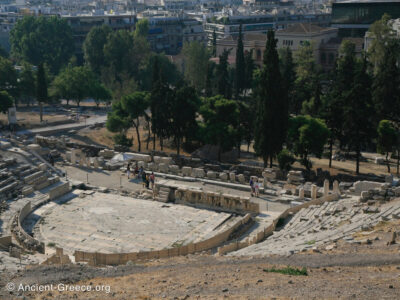The historic theatre is located at the south slope of the Acropolis of Athens, Greece.
The archaeological site label indicates” “The auditorium of the Theatre of Dionysos is the most important building on the Southern Slope of the Acropolis. It was the place where the famous tragedies of Aeschylus, Sophocles and Euripides and the comedies of Aristophanes were first performed in the 5th century BC.
Experts disagree on the exact form of the auditorium at that time, but it is believed to have been smaller and simpler, and perhaps not semicircular. The auditorium only reached its present size when it was rebuilt in stone in the following century. The ambitious rebuilding is attributed to Lykourgos, who controlled public investment in Athens from 338 to 324 BC.
The irregular overall shape of the auditorium is a consequence of the restrictions of the site: on the south the retaining walls of the parodoi (passages), on the east the Odeion of Perikles (5th century BC), on the west and part of the north sides further retaining walls, and on the north the katatome, the curve cut into the rock of the Acropolis. The auditorium is divided into two parts by the Peripatos, a public road which also served as a diazoma, a corridor through the Theatre.
Fourteen staircases in a radiating arrangement divide the auditorium into thirteen cunei (segments). The rows of seats consist of large finely carved blocks of limestone, quarried at the coast of Piraeus. The seats of the front row are exquisite examples of marble carving. The most elaborate seat, in the middle, was reserved for the priest of Dionysos, the god to whom the Theatre was dedicated.
The Theatre of Dionysos became derelict following the fall of the Roman Empire in the 5th century AD and its features gradually disappeared over the following centuries. It was rediscovered by excavation between 1862 and 1895.”
The theater of Zea in Piraeus was modeled after the theater of Dionysus.


